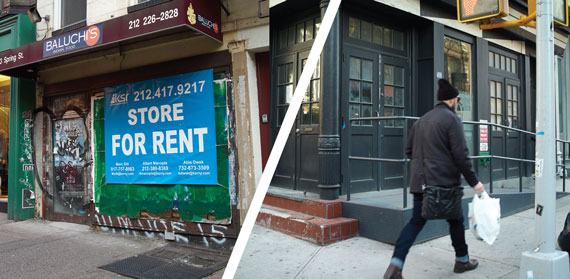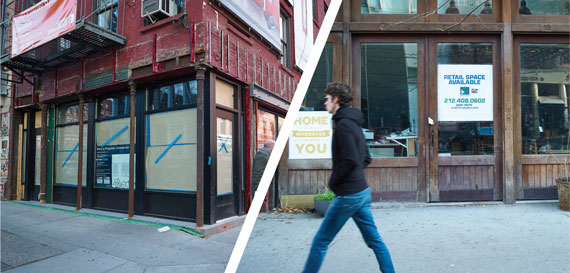At first glance, retail in Soho, one of New York’s biggest and trendiest shopping districts, looks to be as robust as ever. On any given weekend, the big-name stores that line Broadway and West Broadway — from H&M to Zara to Bloomingdale’s downtown outpost — are mobbed with New Yorkers and tourists alike.
But despite all that, Soho is a neighborhood at a retail crossroads.
While the neighborhood has received a lot of attention in recent years for the rising number of available storefronts, the situation has accelerated. This month, with help from the CoStar Group and Agorafy databases, The Real Deal tallied and analyzed all of Soho’s retail availability — properties that are either vacant or occupied by a tenant with a soon-to-expire lease — that is being marketed for rent.
The numbers show at least 95 properties listed as available, totaling nearly 500,000 square feet of space. That availability is highly concentrated on two main shopping thoroughfares — Broadway and West Broadway — as well as on Wooster, Spring and Greene streets.
Soho’s availability rate grew to 20 percent in the third quarter from 9.6 percent in the same quarter last year, according to Cushman & Wakefield’s Manhattan retail market report. This was the biggest year-over-year jump of any Manhattan neighborhood that the firm tracks.
In fact, the numbers have been creeping up over the last few years.
In the fourth quarter of 2013, Soho’s retail availability rate was 12.2 percent, an increase from 8.8 percent in 2012.
Sources say one of the biggest factors behind this increased availability is rising rents, which many tenants simply can’t afford.
Asking retail rents in Soho — which behind certain parts of Midtown are the highest in Manhattan — rose 13.8 percent year-over-year, to $535 per square foot in the third quarter of 2015 from $470 per square foot during the prior year, according to Cushman’s report. (The highest asking rent in the neighborhood, however, is way higher, clocking in at $1,700 per square foot at 489 Broadway, currently home to Ricky’s NYC.)
Availability can be a double-edged sword for landlords: On the one hand, it can allow them to seek higher rents from new tenants, but if space is rampant, prospective retailers have a lot of options to choose from and more bargaining power.
In addition to soaring rents, retail experts attribute the neighborhood’s rising retail availability to a combination of factors, including the migration of tenants south and west and store closings by several big national brands.
But Cushman & Wakefield’s Brandon Singer, who is marketing 503 Broadway, said that the high availability rate is just part of the natural flow of the market, not a reason to sound the alarm on its overall health.
“Look, it’s Soho,” Singer said. “You’re talking about a top retail market in New York City. It’s as good as it gets. Like any other submarket in New York, there’s always upticks and downticks in the availability of space.”
‘The tide turns’
The rent escalation follows a familiar pattern. Over the past decade, longtime tenants were replaced by newcomers drawn by the comparatively low rents, said Aurora Capital’s Jared Epstein, whose firm owns substantial property in Soho, including 568 Broadway, where the retail portion is occupied by Forever 21, Armani Exchange and Equinox. (Armani’s lease of its 20,500-square-foot space expires in February 2017 and will have an asking rent of $1,200 for the ground floor.)
But as Soho has drawn more interest from retailers, rents have hit “record levels throughout the district,” he said.
“At some point in every cycle, the tide turns: Rents rise to uncomfortable levels for retailers, the pace of retail sales slows, retail leasing velocity comes to a halt,” Epstein said.
In Soho, he added, “Many of the availabilities are a product of tenants or landlords seeking to line their pockets by releasing the space at substantially higher rents.”
He added that the neighborhood’s large size — it spans roughly one square mile — also means it’s bound to have more turnover.
“Soho is New York City’s largest shopping district in terms of the amount of blocks and storefronts that encompass it,” Epstein said. “Soho is a shopper’s paradise, but with such a vast amount of stores there will always be spaces with leases expiring.”
The climbing availability along Broadway has been well documented over the last few years, with tenants either moving out or trying to sublease massive spaces.
For example, in 2014, Old Navy ditched its 30,000-square-foot space at 503 Broadway, which is now listed as available. In early 2015, Inditex, the parent company of fast-fashion retailer Zara, purchased Old Navy’s former storefront along with adjoining retail spaces at 503-511 Broadway in a $280 million retail condo deal, which came out to more than $20,000 per square foot and represented a record in Soho. Inditex, which bought Old Navy’s lease that ran through 2018, is currently building out a new space for Zara but the remaining storefronts sit vacant.
Hollister, meanwhile, put its 46,000-square-foot space at 600 Broadway on the sublease market in 2013, a move reportedly precipitated by the brand’s plunge in sales. The company’s lease on the property doesn’t expire until 2026. But the store’s location right outside the Broadway-Lafayette subway station should prove extremely desirable to a brand with more clout, brokers say.
“The brand died a slow death, but that’s a key corner,” said Faith Hope Consolo of Douglas Elliman, who is not involved in the lease but is currently marketing a vacant 4,800-square-foot space at 372 West Broadway, whose last tenant was Tommy Hillfiger. “That’s a billboard,” she said.
Taking a hit
Like Fifth Avenue, the neighborhood is a key spot for retailers to advertise their brands on one of the most highly trafficked corridors in the city. As a result, many are willing to take a hit and pay exorbitantly high rent.
In general, tenants are largely moving west and south, expanding Soho’s borders and testing the waters south of Spring Street, said Winick Realty Group’s Josh Siegelman, who’s brokered several recent Soho deals.
He said there’s also been a heightened interest from international tenants in Soho.
Siegelman represented the landlord, billionaire Jeff Greene, in a 1,550-square-foot lease at 62 Wooster to Swedish perfume brand Byredo, the retailer’s first boutique shop in the U.S. According to Agorafy, the asking rent worked out to $300 per square foot. Siegelman — who also represented Greene in the Japanese clothing store Tomorrowland’s 3,500-square-foot lease in the same building, also known as 476 Broome Street — said he secured record per-square-foot rents for these blocks, though he declined to specify the terms of these deals.
And, he said, the Soho retail market is strong.
“Although there’s vacancy, the interest in Soho has not diminished,” Siegelman said. “In Soho you have an eclectic audience. You’re able to capture residential, office and tourist populations.”
Like many areas in New York City, the character of Soho’s thoroughfares differs by block.

193 Spring Street and 430 Broome Street (Photo: Michael McWeeney)
Sources said tenants need to be strategic about which part of Soho they plant their flag in. Generally speaking, furniture stores congregate in the southern end of the neighborhood, while luxury brands are concentrated on Mercer, Greene and Prince.
This, of course, is not a hard-and-fast rule: Ten years ago, Spring Street was known as “lipstick alley,” for the number of cosmetic stores, like MAC and Makeup Forever, that dotted the street. Now these stores are in the minority.
While the south end of cobble-stoned Wooster Street is mostly made up of art galleries and new construction, the northern end is home to the likes of Adidas
and Chanel.
But according to TRD’s analysis, 10 spaces along Wooster are listed as available, the largest of which is a 40,000-square-foot spot at 105-113 Wooster Street, which is currently occupied by the furniture company Room & Board. The company’s lease will be terminated to make way for the new tenants, said John Brod, partner at ABS Partners Real Estate, which is marketing the property. Room & Board outgrew its space and has already opened a roomier outfit at West 18th Street in Chelsea, Brod said.
He said prices along Soho’s most trafficked streets are way too high, forcing retailers to move to some of the neighborhood’s traditionally quieter thoroughfares.
“What’s happened is streets such as Broadway, Prince and Spring, they’re out-pricing each other,” Brod said. “That’s why Wooster, of all the streets in the area, is seeing a revival.”
Brokers said the market is headed for a correction. Pricing is particularly aggressive on Broadway, according to CBRE’s Richard Hodos, a tenant representative who has worked extensively on Fifth and Madison Avenues and represented Tory Burch in the designer’s flagship store on Mercer Street.
“There’s a glut of space on Broadway in Soho,” he said. “The rents are way, way high. That tells me that we will reach a point where we will see an adjustment on those streets and on those blocks.”

